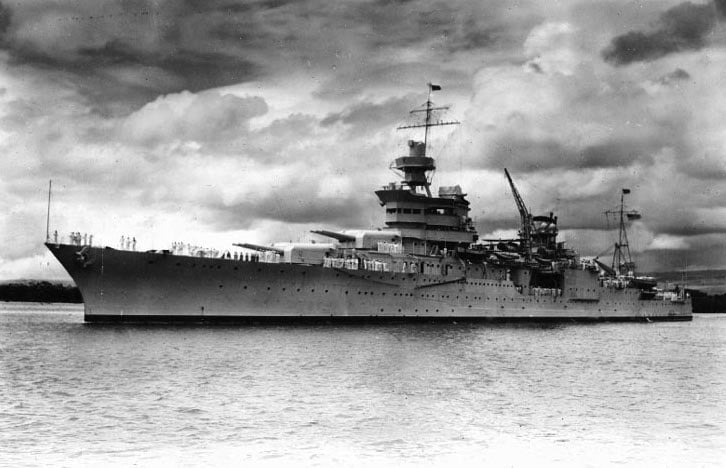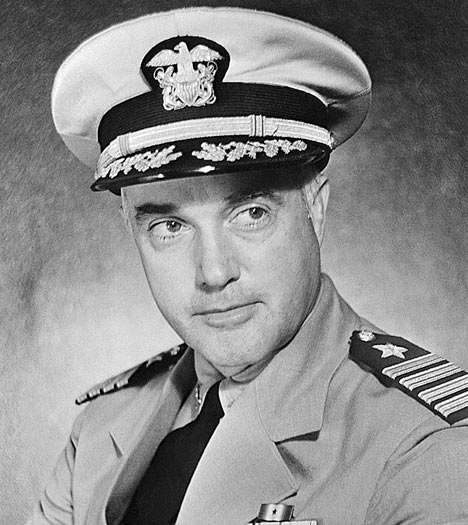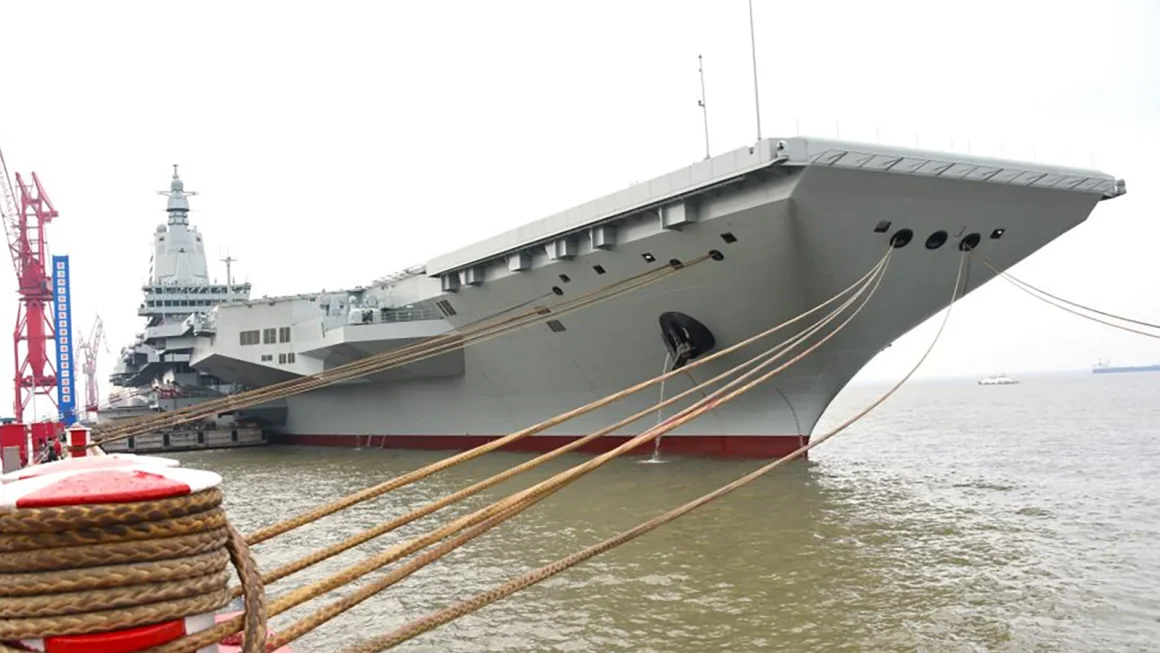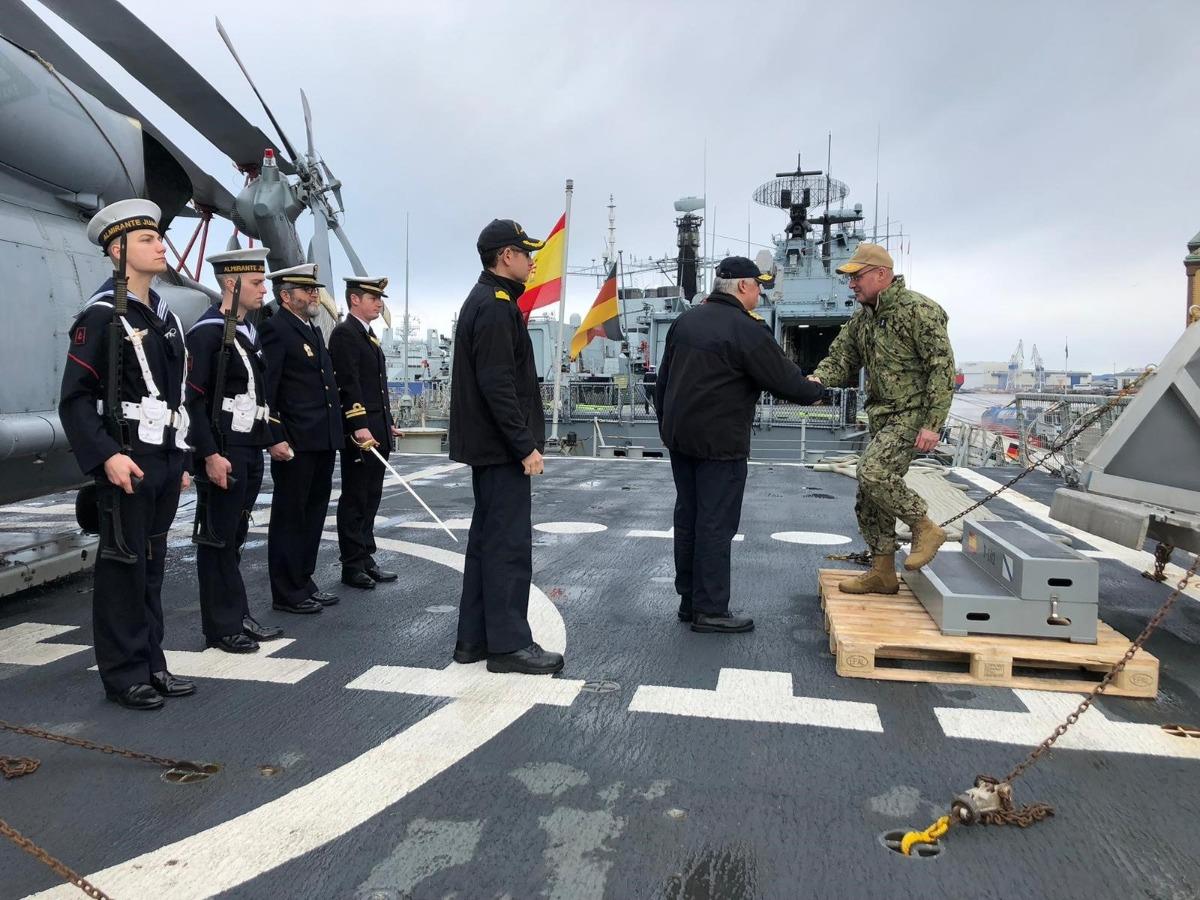
The following is a 1999 article from Proceedings, originally titled: The Sinking of the Indy & Responsibility of Command.
The July 30, 1945 sinking of the heavy cruiser USS Indianapolis (CA-35) by the Imperial Japanese submarine 1-58 has been called the last, great naval tragedy of World War II. It is the stuff of legend: after delivering the atomic bombs to Tinian, the Indy was torpedoed, sinking in 12 minutes. At least 800 crew members survived the sinking and went into the water. On their rescue after five days, only 320 still were alive. Their stories have inspired three books, a movie, and perhaps yet another feature film.
The Indy’s survivors fought sharks, deprivation, and the elements, and now they fight to get their captain exonerated. Their commanding officer, Captain Charles B. McVay III (above), is the only captain ever to be court-martialed for having his ship sunk out from under him during time of war.
The group of men that stood before me that warm Hawaiian afternoon could have passed for those in any retirement community. As I looked at them, I searched for something in their faces that might reveal the incredible suffering they had endured, something that might identify them as the heroes they were. There did seem to be an intensity of spirit—a fire in their eyes—that belied their advancing years, but other than that, as hard as I looked, I saw no hint of the true horror that they must have hidden within them. And nothing that would provide a clue to the casual observer of just how incredible these men really were.
But I was in awe of them just the same. These were survivors of the sinking of the heavy cruiser Indianapolis (CA-35), and they had assembled in Pearl Harbor to witness the inactivation of my submarine, bearing the same name. As commanding officer (CO), I thought it appropriate to ask these men to stand with my crew as we decommissioned our boat, since they never got to say good-bye to their own vessel in this fashion. I thought their presence might drive home the realization that as bad as it is to decommission a perfectly good submarine, there are worse fates for a ship. I also thought it would inspire my crew to have these men stand in formation with us one last time, as one crew—the combined crew of the Indianapolis.
Indeed, the ceremony went off beautifully on that day in February 1998. At the reception following, however, one of the survivors—Paul Murphy, president of the survivor’s association, and as brave a man as I have ever known—approached me. He thanked me for inviting his crew to the ceremony. He said that standing in formation as the Indy crew once again, in Pearl Harbor, would be something they would never forget. And then, when he had me right where he wanted me, he threw in the kicker.
“We were thinking,” he said, “that there may never be another USS Indianapolis to carry on the reputation of our ship. That means you’re the last Indy captain. Another Indy captain needs you—and some of us think you have a duty to respond to his call.”
To be honest, I was not surprised by this request. After three tours in the submarine Indianapolis, I knew well the legend of the cruiser for which we were named. I knew the story of Captain Charles Butler McVay III, knew of his court-martial, and knew his two sons. I had spoken to many Indy survivors over the years, and knew that they were unanimous in their opinion that their captain had been wrongly prosecuted. The Indy was sunk by a submarine, and I was a submarine CO. Hence, I could analyze the attack with a trained eye to evaluate whether McVay’s actions had been appropriate. That was why these men were coming to me. I was their logical choice to bring this issue to closure. It all made sense.
But I dreaded the request just the same.
Not because I feared controversy—for, with apologies to the late Senator Goldwater, passivity in response to injustice is no virtue, and controversy in defense of truth is no vice.
Not because it would be work—I already had done the research. Over the years I had become very familiar with the facts surrounding the sinking of the Indianapolis. I had twice laid wreaths at the site of her sinking. I even made a failed attempt to meet Commander Mochitsura Hashimoto, the captain of the submarine that sunk her. I had read virtually every book, article, and document ever written on the event.
I dreaded the petition because I wasn’t sure the survivors would want to hear what I had to say. Nevertheless, these men have inspired me greatly over the years, so I honored their request.
The Court-Martial

The Indy controversy erupted in August 1945, just after the atomic bombs were dropped. The American public was outraged at the loss of more than 800 lives in the waning days of the war, and a Navy court of inquiry was convened to investigate. Its recommendation was that Captain McVay be court-martialed for hazarding his vessel by failure to zigzag, but Admiral Chester Nimitz disagreed and instead issued the captain a letter of reprimand. Admiral Ernest King later overturned Nimitz’s decision and recommended a court-martial, which Secretary of the Navy Forrestal later convened.
In doing so, King intervened directly with the Secretary of the Navy to move forward with the court-martial in parallel with an investigation by the Inspector General (IG). But a court-martial is a trial, not an investigatory tool. If King’s problem was simply a lack of information, why didn’t he allow the Inspector General to issue his report before ordering the court-martial? Some believe it is because King was not satisfied that the IG’s conclusions would support his decision to court-martial.
The Navy Judge Advocate General also was asked to review the referral. His response contained the curious statement that the charges included in the initial referral were “the only ones that can be supported,” as if an agenda was at work to establish a greater foundation for prosecution. Whatever the truth, this statement certainly creates the perception that the Judge Advocate General was under direction to discover more charges to refer against McVay.
In the end, McVay was charged with two counts: suffering his vessel to be hazarded by failing to zigzag, and failure to order abandon ship in a timely manner. His counsel, reportedly hand-picked by King, had never argued a case in court before.
The court claimed that McVay was not being charged for any deficiency that led to the sinking of his ship. They made a strong case that the “Indianapolis was hazarded before she was ever detected by I-58, and would have been hazarded if she had never been detected by I-58.” In essence, McVay could have been found guilty in a court– martial even if his ship had not been sunk. This is a meaningless legal distinction, however, since absent the sinking, there would have been no way for anyone to know that the vessel had been hazarded.
Hence, despite the fact that McVay was convicted only on the first count—for suffering his vessel to be hazarded by not zigzagging—there is no way to escape the fact that Captain McVay was court-martialed for having his ship sunk.
Put all these facts together, and it is understandable why most of the survivors believe that Admiral King was doing all he could to tilt the scales of justice against McVay. Even Admiral Nimitz later would say to one survivor that the entire affair involving the court-martial was a mistake and should never have happened.
Modern Perceptions and Recent Analysis
In more recent times, the story of the Indianapolis has become the stuff of legend. Unfortunately, the legend has in some cases overwhelmed the truth. For example, some of McVay’s proponents opine that the Navy still is involved in some sort of cover-up, to hide the corporate Navy’s culpability in the events that led up to the McVay court-martial. Any such notion obviously is ludicrous. No one on active duty today has any stake in a court-martial decision made in 1945. None of today’s decision makers has any personal capital invested in this sequence of events. It would reflect poorly on none of them if they were to declare that McVay should not have been court-martialed almost 55 years ago. It is reasonable to conclude, therefore, that any contemporary declaration on the case is likely to be unbiased.
Which leads to the issue of recent statements on the subject by the Navy. The most recent review of the case was carried out by a Navy lawyer, Commander R. D. Scott, in 1996. The study is thoroughly researched, logically sound, and I will assume, legally correct. Nevertheless, some statements in the report show a lack of professional knowledge of the naval art, weaken the overall presentation, and unfortunately, lend credence to those who contend that the Navy still is engaged in shaping the argument against Captain McVay.
For example, in one of his footnotes, Commander Scott says, “The Navy has never challenged Captain McVay’s uncorroborated account that he did not go down with his ship because he was swept over the side by a wave.” The implication here is that it was McVay’s duty to go down with his ship, a notion that is steeped in folklore but has no foundation in regulation or naval tradition. Worse, Scott implies here that Captain McVay—a man awarded the Silver Star for gallantry under fire, a man who spoke freely and honestly about the fact that he had not been zigzagging at the time he was torpedoed—was lying about something as trivial as how he found himself removed from his sinking ship. This is an implication that most of the survivors consider personally offensive, as do I.
Similarly, Scott is particularly critical of one recent book that recounts the story of the Indianapolis, Fatal Voyage. He proclaims this account “replete with melodramatic conjecture,” but this has nothing to do with the veracity of the claims made by the author. In addition, Scott is anything but clinical in his analysis of the book, as when he describes author Dan Kurzman writing his missive with a “tortured pen.”
Scott also writes that existing naval warfare publications directed commanding officers to zigzag anywhere a threat of submarine attack existed. By July 1945, however, the Imperial Japanese Navy barely existed, and the Philippine Sea where the Indianapolis was sunk was thought of as a backwater with an imperceptibly small probability of encountering the enemy. In addition, the Indianapolis’s routing order, which even Admiral Nimitz noted took precedence over the doctrine publication, gave McVay authority to zigzag “at his discretion.” And last, McVay had been zigzagging throughout the daylight hours, and ordered a straight-line course only late in the evening, when the sky was obscured and visibility was poor. These facts weakened this line of reasoning so acutely that the prosecution never pursued a strategy of convicting McVay for failing to follow a lawful order.
Commander Scott also performs a naive assessment of the I-58’s attack, concluding that if the Indy had zigged at the time the submarine launched her torpedoes, the weapons would have missed. Notwithstanding the laws of probability that argue against this kind of fortuitous timing, combat is not a kid’s game where everybody goes home after experiencing initial frustration. Even if the I-58 had missed with the first salvo, she had other options at hand: she could have employed her Kaiten or suicide minisubmarines, which were guided; or she could have surfaced, repositioned, and pressed on the attack. Many of the U.S. Navy’s most successful submarine commanders of World War II missed their initial attack but still achieved success. These men sank more than 4,000 ships, most of which were zigzagging. Scott exaggerates the difficulty that zigzagging would have presented to the commander of the I-58, and to propose that the Indy would have been spared had she zigged at time of fire weakens his overall argument.
In addition, Scott’s assertion that zigzagging would have helped save the Indianapolis weakens his later statement that “whether zigzagging would have defeated submarine I-58’s targeting of Indianapolis was not the issue at Captain McVay’s court-martial.” If the efficacy of zigzagging was not the issue, why did the Navy’s advocate in this matter spend so much effort trying to show that it would have been effective? Because he had to overcome the weight of evidence, most of which was provided by two men—the I-58’s captain, who was flown into Washington to testify against Captain McVay at his court– martial, and an experienced U.S. submarine commander. Even the prosecution’s star witness, the CO of the attacking submarine, agreed that the Indy would have been sunk regardless of McVay’s maneuvers.
The truth is that despite the Navy’s claims to the contrary, McVay was convicted for having his ship sunk. And in the end, Commander Scott’s assessment did little to assuage survivors’ concern that their skipper continues to receive unjust treatment at the hands of the Navy.
The Responsibility of Command
Despite the weaknesses in Commander Scott’s analysis of the McVay case, his conclusions essentially are correct. But he misses the real point. The question that should be asked is, If a ship with no antisubmarine warfare capability is sunk by a submarine in a war zone, is the commanding officer free from accountability?
The short answer is no. Regardless of legal wrangling, a commanding officer’s responsibility, and his accountability, are absolute in matters that affect the safety of his ship. This tenet is founded in Section 5947 of Title 10, United States Code, which states: “All commanding officers . . . in the naval service are required . . . to take all necessary and proper measures, under the laws, regulations, and customs of the naval service, to promote and safe-guard . . . the physical well-being, and the general welfare of the officers and enlisted persons under their command or charge.”
Or, as another Navy captain has said:
In the American Navy, the principle of accountability for the safety of one’s crew derives directly from our long-standing tradition of the citizen-soldier. The Founding Fathers explicitly rejected the European tradition of a professional officer caste that puts its own stature and survival above that of troops forcibly drawn from the peasantry. Instead in our democracy, the military leader’s authority over his troops was linked to a parallel responsibility to them as fellow citizens.
Accountability is a severe standard: the commander is responsible for everything that occurs under his command. Traditionally, the only escape clause was an act of God, an incident that no prudent commander could reasonably have foreseen. The penalties of accountable failure can be drastic: command and career cut short, sometimes by court-martial.
These factors favor the argument that a commander can and should be court-martialed for a failing that results in members of his crew being hurt or killed. Any deficiency in the ship is the CO’s responsibility, even if he had no direct, causal relationship with the deficiency. This is because it is the commanding officer’s responsibility—more than that, his duty—to ferret out and correct problems before they manifest in failure. If he fails at that task, there is no one to back him up.
Captain McVay was the son of an admiral, a second– generation Naval Academy graduate, and knew this well. He acknowledged his accountability on two separate occasions. First, after his rescue, he told the New York Times, “I was in command of the ship and I am responsible for its fate.” And later, in his court-martial, he testified, “I know I cannot shirk the responsibility of command.”
Captain McVay’s ship was lost. He failed to take “all necessary measures” to protect his ship. And in our system of responsibility of command, it does not matter whether that action would have been effective—he should have tried. That is why he was found guilty.
Legal Correctness and Justice
So it seems that Captain McVay’s conviction was legally correct. But was it just?
Out of several hundred ships sunk during World War II, Captain McVay was the only commanding officer ever to be court-martialed for having his ship sunk out from under him. Was every one of those other commanding officers faultless? Did every one of them take “all necessary measures” to protect his crew? Of course not. If those cases were subjected to the same level of scrutiny as the Indy, we probably would find some kind of failure in each event.
So why doesn’t the Navy routinely court-martial commanding officers when their ships are sunk?
Consider how polite society responds to the death of a child. The parent sometimes has some degree of responsibility. Perhaps he left the child home alone. She let the child play too close to the street. Or they left matches in an accessible location. The parents could have prevented the tragedy—they might even be criminally negligent—but a humane society considers the impact of the tragedy on the accused, and understands that absent the grossest kind of malfeasance, the parent has suffered enough and should not be prosecuted. This is the concept of prosecutorial discretion. So it is with the sinking of a ship. The CO almost always can be found technically guilty of some form of negligence.
Indeed, a CO’s responsibility is so vast that on almost any day, on almost any ship, any one of us could walk on board and find something for which the CO could be held legally culpable. But absent the worst kind of deliberate misconduct, COs are not routinely prosecuted, because pursuing this tenet too aggressively would result in an effusion of action tailored to prevent failure, rather than to pursue success.
Which brings us back to Captain McVay. Here was a man who, because of the unique and absolute nature of the responsibility of command, was culpable for the misfortune that befell his ship—the captain’s own statements point to the fact that he understood this truth well. Despite that, there was nothing he could have done to prevent that misfortune, and he never should have been prosecuted in the first place. The lesson here is that a decision can be legally correct and still be unjust.
It is worth pointing out that McVay’s jury understood this paradox, and as a result, his sentence was light. He did not get demoted, as is commonly thought, but was merely set back in line for promotion. In addition, the members of the court-martial were unanimous in recommending that the reviewing authority exercise clemency. Why? Because they knew that, but for the grace of God, any one of them might have found himself in the same position as Captain McVay.
In fact, following the court-martial, Admiral King recommended setting aside even this token punishment. Secretary Forrestal accepted this recommendation, and McVay was promoted to rear admiral on retirement, consistent with the practice of the day.
An Epilogue
From 1945 on, McVay received hate mail every Christmas from a few persistent relatives of sailors killed on the Indianapolis. The support he received from fellow survivors did little to assuage his feelings of inadequacy and guilt, made worse by the fact that his conviction rendered him legally culpable for the deaths of his shipmates. On a gray day in 1966, he dressed in his Navy uniform, picked up a toy figure of a sailor, walked onto his front porch, put a handgun into his mouth, and pulled the trigger—yet another victim of a battle that claimed too many.
Because McVay’s punishment had been set aside, the only historical vestige of the Indianapolis incident is that McVay’s service record continues to reflect a conviction. Because this has caused him to be viewed as a felon, it continues to rankle his survivors, who insist their captain should not be considered a criminal because of an event over which he had no control. Hence, they continue to work to get even this black mark removed from his legacy.
Failing with the Navy, they have taken their battle to the court of public opinion and into the halls of Congress. And every few years, a few of them manage to get a bill or resolution entered into one chamber or other, trying to clear his record, if not his name. Perhaps one day they will succeed. But they work with an intensity that reveals that they know their time is limited.
It already is too late for Captain McVay to know that the battle being fought on his behalf one day may be won. Now the survivors themselves, having survived one of the most terrible ordeals in human history, wonder if any one of them will be around to see how the final chapter of this tale will be written.





